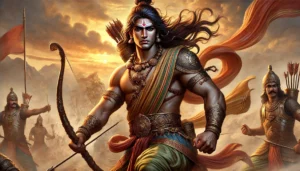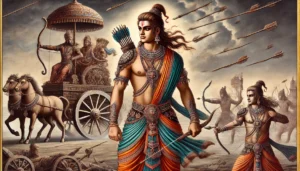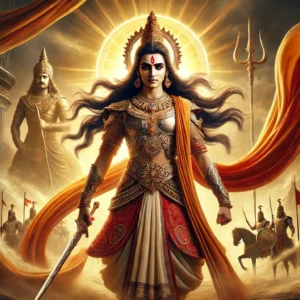
Shikhandi the key to death of Bhishma
Shikhandi: The Catalyst of Bhishma’s Fall
In the epic saga of the Mahabharata, the character of Shikhandi emerges as a poignant reminder of the interconnectedness of karma, destiny, and human agency. Shikhandi’s story is not merely one of vengeance but also of transformation, purpose, and the fulfillment of cosmic justice. His pivotal role in Bhishma’s downfall not only altered the course of the Kurukshetra war but also underscored the epic’s intricate philosophical themes. This article explores Shikhandi’s journey as the reincarnation of Amba, his role in Bhishma’s demise, and the lasting legacy of his actions.
Amba’s Plight and the Seeds of Revenge
The origins of Shikhandi’s mission lie in the tragic tale of Amba. As the eldest daughter of the King of Kashi, Amba was abducted by Bhishma during her swayamvara, along with her sisters Ambika and Ambalika. While the latter two accepted their fate, Amba, already in love with King Salva, pleaded for her freedom. Though Bhishma released her, Salva rejected her, perceiving her as tainted by her association with Bhishma.
Rejected and dishonored, Amba returned to Bhishma, demanding that he marry her to restore her honor. However, Bhishma, bound by his vows of celibacy and service, refused. Betrayed by fate and spurned by the two men who could have saved her dignity, Amba vowed revenge. Her penance to Lord Shiva earned her a boon: she would be reborn as the cause of Bhishma’s death. However, her journey to fulfill this vow would span lifetimes.
The Rebirth as Shikhandi
Amba was reborn as Shikhandi, the child of King Drupada. Shikhandi’s birth came with its own set of complications. Though born biologically female, the soul carried the spirit of a warrior and a seeker of vengeance. This duality would define Shikhandi’s identity and destiny. As Shikhandi grew, the divine prophecy surrounding his life became evident.
In an attempt to align with his warrior spirit and to fulfill the purpose of his reincarnation, Shikhandi underwent a transformative journey. With the help of a yaksha (a celestial being), Shikhandi acquired male physical attributes, solidifying his identity as a warrior capable of facing Bhishma on the battlefield. This transformation is symbolic of Shikhandi’s resolve to overcome societal and personal barriers to achieve his destiny.
Table of Contents

Shikhandi the key to death of Bhishma
The Kurukshetra War: Shikhandi’s Moment of Destiny
When the Kurukshetra war began, Bhishma stood as an indomitable force on the side of the Kauravas. His unparalleled skills, combined with his boon of ichha-mrityu (the ability to choose the time of his death), made him invincible. Despite their valor, the Pandavas found themselves unable to defeat him.
On the tenth day of the war, Lord Krishna, the strategist and charioteer of Arjuna, devised a plan to use Shikhandi’s unique identity against Bhishma. Krishna reminded the Pandavas of Bhishma’s vow never to harm a woman or someone he perceived as a woman. Shikhandi, carrying the essence of Amba, was the key.
During the battle, Arjuna positioned Shikhandi at the forefront of his chariot. Seeing Shikhandi, Bhishma recognized the reincarnation of Amba and, true to his vow, lowered his weapons. In that moment of hesitation, Arjuna unleashed a torrent of arrows, striking down Bhishma. While it was Arjuna’s arrows that pierced Bhishma’s body, it was Shikhandi’s presence that made the act possible.
Symbolism and Philosophical Underpinnings
Shikhandi’s role in Bhishma’s downfall is layered with deep symbolism. On one level, Shikhandi represents the inevitability of karma. Bhishma’s actions during Amba’s lifetime, though guided by his duty, set into motion a chain of events that culminated in his own defeat. The Mahabharata repeatedly emphasizes that even the noblest of individuals are bound by the consequences of their actions.
On another level, Shikhandi’s story challenges traditional notions of gender and identity. His transformation highlights the fluidity of identity and the power of the human spirit to transcend societal norms to fulfill a higher purpose. In a text as ancient as the Mahabharata, Shikhandi’s narrative stands as a progressive exploration of individuality and destiny.

Shikhandi the key to death of Bhishma
The Aftermath and Legacy
Bhishma’s fall marked a turning point in the Kurukshetra war. With their mightiest warrior incapacitated, the Kauravas’ morale was severely shaken, paving the way for the Pandavas’ ultimate victory. Shikhandi’s role in this event cannot be overstated. By serving as the catalyst for Bhishma’s defeat, Shikhandi not only fulfilled Amba’s vow but also ensured the progression of the larger cosmic plan.
Shikhandi’s legacy is twofold. On one hand, he is remembered as the embodiment of vengeance and the fulfillment of a divine promise. On the other hand, his story is a testament to the power of resilience and purpose. Despite the challenges of his identity and the burden of his past life, Shikhandi rose above societal judgments to play a pivotal role in one of history’s greatest epics.
Conclusion: A Tale of Karma and Redemption
The story of Shikhandi is a vital thread in the grand narrative of the Mahabharata. It illustrates the epic’s core themes of karma, dharma, and the cyclical nature of existence. Shikhandi’s life serves as a reminder that no action is without consequence and that destiny often finds its fulfillment through unexpected means.
Through his role as the catalyst for Bhishma’s fall, Shikhandi became an agent of cosmic justice, demonstrating that even the mightiest of heroes are not immune to the repercussions of their past deeds. His journey from Amba’s sorrow to Shikhandi’s triumph is a tale of transformation, resilience, and the power of purpose—an enduring lesson from one of India’s greatest epics.

Shikhandi the key to death of Bhishma
FAQs on Shikhandi: The Key to Bhishma’s Defeat and Amba’s Vengeance
- Who was Shikhandi in the Mahabharata?
Shikhandi was a complex character in the Mahabharata, born as the reincarnation of Amba, a princess wronged by Bhishma. Raised as a prince in Panchala, Shikhandi was both a warrior and a symbol of karmic retribution, destined to play a critical role in the downfall of Bhishma during the Kurukshetra War.
- Why was Shikhandi born as a reincarnation of Amba?
Amba, who was abducted by Bhishma but rejected by both her intended suitor and Bhishma himself, vowed revenge after her humiliation. She sought justice but was denied it in her lifetime, leading to her intense penance and rebirth as Shikhandi. This reincarnation was meant to fulfill her vow of avenging Bhishma.
- What transformation did Shikhandi undergo to fulfill Amba’s vow?
Shikhandi, though born female, was raised as a male prince to maintain the royal lineage. According to some versions of the Mahabharata, Shikhandi later acquired masculinity through a divine boon or transformation granted by a yaksha, ensuring his role as a warrior capable of standing against Bhishma.
- How did Shikhandi contribute to Bhishma’s defeat in the Kurukshetra War?
On the 10th day of the war, Shikhandi was placed in front of Arjuna during the battle against Bhishma. Bhishma, bound by his principles of not fighting a woman or someone with feminine origins, refused to attack Shikhandi. This hesitation allowed Arjuna to shoot the fatal arrows that incapacitated Bhishma, leading to his eventual fall.
- What was Bhishma’s vow, and how did it become his weakness?
Bhishma’s vow of lifelong celibacy and devotion to the Kuru throne was his strength and pride. However, his rigid adherence to his principles, such as his refusal to attack Shikhandi, turned into a fatal weakness when he faced someone tied to his past actions and bound by karmic retribution.
- Why did Bhishma refuse to fight Shikhandi?
Bhishma considered Shikhandi to be Amba reborn. As per dharma, Bhishma refrained from attacking women or those with a feminine past, which aligned with his deeply ingrained moral code. This refusal left him vulnerable in the battlefield.
- What role does Shikhandi’s story play in the Mahabharata’s larger narrative?
Shikhandi’s story intertwines themes of justice, revenge, and the consequences of dharma. It highlights how unresolved conflicts from the past can resurface, and how personal vows or moral codes can conflict with practical realities in times of war.
- What is the significance of Shikhandi’s character in the Mahabharata?
Shikhandi represents a bridge between justice and vengeance. His character emphasizes the importance of karma and retribution, while also questioning societal norms regarding gender, identity, and morality.
- What lessons can be drawn from the relationship between Shikhandi and Bhishma?
Their relationship teaches that even the greatest warriors are not immune to the consequences of their actions. Bhishma’s unwavering adherence to his principles, while admirable, ultimately led to his vulnerability. Shikhandi’s role demonstrates the inevitability of karmic justice and the need for introspection on past actions.
- How does Shikhandi’s story challenge societal norms?
Shikhandi’s gender identity and transformation challenge traditional notions of masculinity and femininity in ancient Indian society. His journey also questions the rigid application of dharma, showing how circumstances can blur moral boundaries.
- How did Shikhandi acquire the strength and weapons to face Bhishma?
According to certain retellings, Shikhandi underwent training in warfare and weaponry to prepare for the Kurukshetra War. His resolve to fulfill Amba’s vow drove him to become a skilled warrior, capable of holding his ground against a formidable opponent like Bhishma.
- What was Arjuna’s role in the strategy involving Shikhandi?
Arjuna played a crucial role in utilizing Shikhandi as a shield against Bhishma. Understanding Bhishma’s hesitation to attack Shikhandi, Arjuna strategically positioned himself to deliver the decisive blows, effectively leveraging Shikhandi’s presence on the battlefield.
- What karmic themes does Shikhandi’s story reflect?
Shikhandi’s tale is a powerful representation of karma. It shows how unresolved wrongs can return in unexpected forms and how justice, even when delayed, ultimately prevails. It also reflects the cyclical nature of actions and their consequences.
- How does Shikhandi’s story resonate with modern audiences?
Shikhandi’s story resonates in modern times as a tale of perseverance, identity, and justice. His struggles and transformation challenge conventional gender roles and highlight the need for accountability and redemption, making it relevant to contemporary discussions on morality and equality.
Summary
Shikhandi is a crucial figure in the Mahabharata, serving as a unique catalyst in the downfall of the great warrior Bhishma. His story is deeply intertwined with themes of vengeance, destiny, and gender identity, making his character one of the most intriguing and complex in the epic.
Shikhandi is the reincarnation of Amba, a princess whose life was shattered by Bhishma. Amba had been abducted by Bhishma along with her sisters Ambika and Ambalika to be wed to his half-brother, Vichitravirya. However, Amba, who was already in love with the king of Shalva, pleaded for her freedom. Bhishma allowed her to leave, but her betrothed rejected her, considering her tarnished due to her abduction. Feeling betrayed and humiliated, Amba sought vengeance against Bhishma, but her attempts to rally warriors to her cause failed. Finally, she undertook severe penance and was granted the boon to be reborn as a cause of Bhishma’s death.
Reborn as Shikhandi, the child of King Drupada, Amba’s destiny came full circle. Shikhandi was born biologically female but raised as a male due to a prophecy, later acquiring masculinity through divine intervention. This fluidity of gender identity made Shikhandi both a powerful warrior and a symbolic figure in the narrative. Shikhandi’s androgyny became a key factor in Bhishma’s fall, as Bhishma had vowed never to raise his weapons against a woman or anyone with feminine attributes.
During the Kurukshetra war, Shikhandi was strategically placed by Arjuna to confront Bhishma. Knowing Shikhandi’s origins, Bhishma refused to fight, perceiving him as a reincarnation of Amba and thus part of his moral code to abstain from combat. This hesitation allowed Arjuna to launch a devastating volley of arrows, ultimately incapacitating Bhishma. Shikhandi’s presence was instrumental in breaking Bhishma’s invincibility, making him a key figure in shifting the course of the war.
Shikhandi’s story raises profound questions about dharma (righteousness), gender norms, and the cyclical nature of vengeance. His journey reflects the complexities of identity and the inevitability of fate in the Mahabharata. By serving as the instrument of Bhishma’s downfall, Shikhandi not only fulfills Amba’s oath of vengeance but also exemplifies how deeply personal vendettas can intertwine with the larger cosmic order.
Related Articles
- Restful Nights: Ayurvedic Remedies and Traditional Indian Practices to Overcome Insomnia and Late-Night Habits
- The Tridevi: Lakshmi, Saraswati, and Parvati – Their Roles and Powers
- “Divine Creatures of Ancient Indian Scriptures: Exploring the Role of Animals in the Vedas, Puranas, and Mahabharata”
- Nature and Spirituality: Exploring the Sacred Essence of the Himalayas, Ganga, and Other Natural Wonders”
- “Reviving the Gurukul System: Relevance and Lessons for Modern Education”
- “Exploring Greek and Indian Mythology: Similarities Between Greek and Indian Mythology “
- “Embracing Sattvic Living: Harmonizing Mind, Body, and Soul Through Food and Lifestyle”
- “Charity and Prosperity: Exploring the Concept of Daan and Its Financial Relevance in Modern Life”
- How to Build an Eco-Friendly Home Inspired by Vastu Shastra
- Comparison of Ancient and Modern Sports: How Traditional Sports Have Influenced Contemporary Games
- “Timeless Lessons from Ancient Tales: Linking Samudra Manthan and Ganga’s Descent to Modern Ecological Challenges”
- “Reviving Sanskrit: How AI is Preserving Ancient Languages for the Future”
- “Mathura: The Sacred Land of Lord Krishna’s Divine Leelas”
- Investing for Future Generations: Lessons from Indian Traditions on Legacy Building and Wealth Preservation
- “Ancient Indian Wisdom: Timeless Lessons for Tackling Today’s Climate Crisis”
- “Artificial Intelligence and Spirituality: Transforming Ancient Practices for the Modern World”
- “Gold and Real Estate in India: Timeless Assets Shaping Financial Strategies”
- Tradition Meets Innovation: The Evolution of Technology in Hindu Rituals
- End-of-World Myths: Exploring Kali Yuga in Hinduism and Ragnarök in Norse Mythology
- Garuda, Pegasus, and Dragons: The Universal Ties of Mythical Beasts Across Cultures
- “Ancient Vimanas: Mythical Flying Machines or Evidence of Advanced Technology?”
- Time Travel in Hindu Mythology: The Fascinating Tales of Kakudmi and King Raivata
- “Divine Feminine Power in Hindu Mythology: The Legends of Durga, Saraswati, and Lakshmi”
- “Divine Beings of Sanatan Dharma: The Spiritual Significance of Sacred Animals in Hinduism”
- “Symbolism in Mythological Art: Unlocking Hidden Meanings in Ancient Temple Carvings”
- “Exploring Technological Advancements in Ancient India and Civilizations: Vimana, Metallurgy, & Water Management systems”
- Unveiling the Mysteries: Ancient Temples of Sanatan Dharma , Mysterious Temples of India
- “The Scientific Knowledge of Sanatan Dharma: Ancient Wisdom Meets Modern Science”
- Ancient Indian Sports and Games: Celebrating a Legacy of Skill, Strength & Strategy”
- “Exploring the Cosmic Link: The Connection Between Astronomy and Vedic Astrology”
- The Power of Sanskrit: Unlocking the Divine Language of the Gods
- “The End of Kaliyuga: A Sanatan Insight into the World’s Final Chapter”
- Explore more articles on Prachin Sanatan Yuga.
Shikhandi the key to death of Bhishma Shikhandi the key to death of Bhishma Shikhandi the key to death of Bhishma Shikhandi the key to death of Bhishma Shikhandi the key to death of Bhishma

